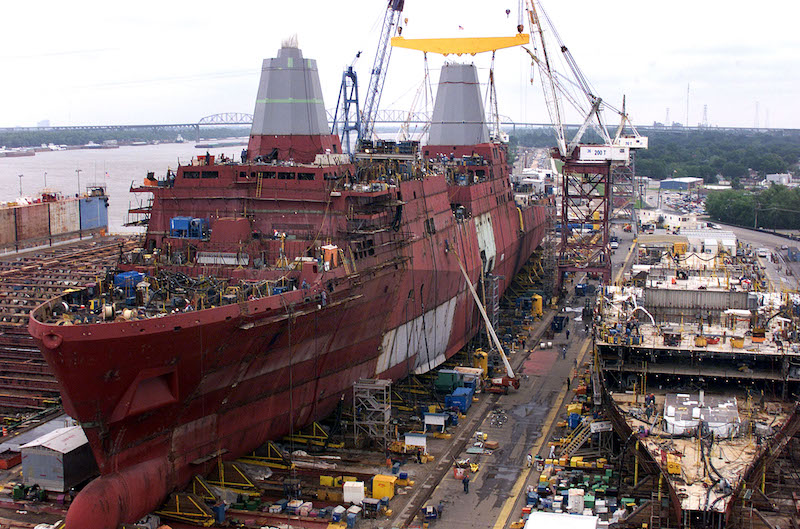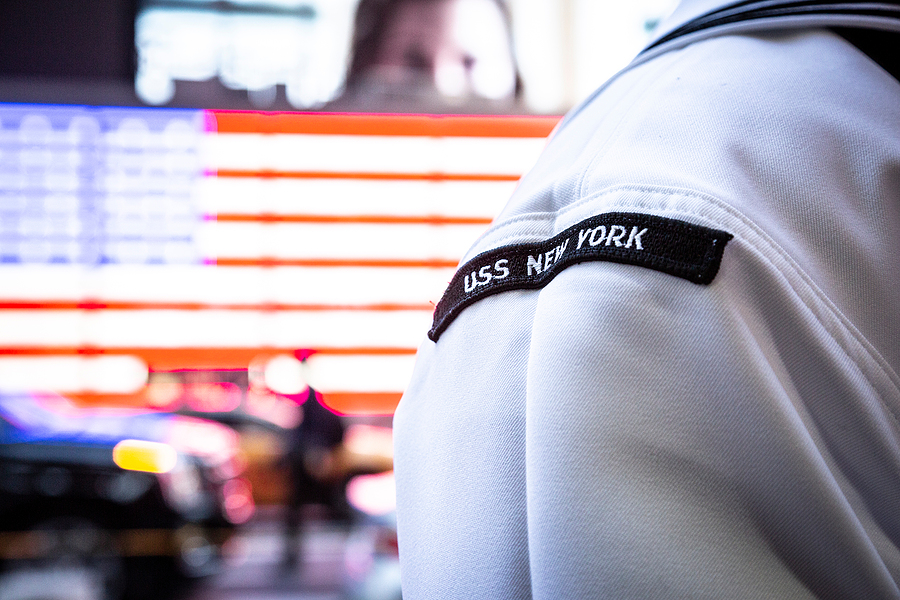On September 11th, 2001, the unthinkable happened when four airplanes were hijacked by militants associated with the extremist group al Qaeda. Of the four planes, two were flown into the twin towers of the World Trade Center in New York City. Almost 3,000 people were killed during these terrorist attacks resulting in not only major US initiatives to fight terrorism but also paths of grief for all Americans. To recognize that grief and commemorate the victims of these 9/11 attacks, the U.S. Navy commissioned the USS New York (LPD-21), one of six Navy ships with New York in the name. This ship was different though. This ship, the USS New York (LPD-21) is a massive ship with 7.5 tons of steel recovered from the World Trade Center and Ground Zero. The steel is forged into its bow of the ship which is significant. It symbolizes the strength and resiliency of citizens as the ship sails forward, around the world. In fact, the motto of the USS New York (LPD-21) is “Strength forged through sacrifice. Never forget.”
Although named after New York, the USS New York (LPD-21) was not constructed there. This mighty ship was constructed at the Northrop Grumman Ship Systems/Avondale Shipyard in Avondale, Louisiana.

The steel from Ground Zero was melted down at Amite Foundry and Machine in Amite, Louisiana. Not only was Amite Foundry and Machine close to the shipyard, they also had the capacity to do a job of this size. You could say the foundry specializes in jobs of this size. They’ve been known to turn down molding jobs for product weighing less than 1,000 pounds and are also known to make mold products that weigh as much 119,000 pounds. Depending upon the economy, Amite Foundry and Machine has a goal of producing 24 million pounds of metal per year. How did they make the bow stem? By melting a total of 24 tons of steel (7.5 tons of that being from Ground Zero) and molding it into the bow stem. With the bow being front and center of the ship, the steel from Ground Zero will lead the way everywhere it goes.
With the bow completed, the rest of the ship was constructed. To construct a ship, the process starts with steel plates longer and wider than an average bus. These plates are cut into panels, bent on hydraulic presses to match the shape of the ship (or rolled to form the needed contour). Once formed, these panels are painted then welded together to form sub-assemblies of the ship. Once complete, the sub-assemblies are moved by large cranes and transport vehicles across the shipyard to the final build location of the ship. While all of this is occurring, the ship is also built out with internal mechanisms, equipment, cabling, etc. You can find a great video of this process (and really understand the sheer size of the process) here. Once the ship is close to being completed, it will be launched into the ocean where the final touches are added internally and it’s prepped to start sail.
Final touches include:
- A New York City subway sign from the station beneath the World Trade Center
- A display case of hats and uniforms from first responders (including a firefighter’s helmet)
- A mural of the twin towers with the words Never Forget
- A banner with the many names of the victims of 9/11
A general timeline of the USS New York (LPD-21) is as follows:
- August 2002: New York’s Governor (George e. Pataki) receive approval for his request that a United States surface warship bestow the name of New York to honor the victims of 9/11.
- August 2003: Northrop Grumman Ship Systems is awarded the contract to build the USS New York (LPD-21).
- September 2003: Amite Foundry and Machine melted steel down to form the bow stem of the ship.
- March 2008: the USS New York (LPD-21) was christened in a ceremony at shipyard.
- August 2009: the ship was delivered to the Navy.
- October 2009: the ship set sail for Norfolk, Virginia.
- November 2009: the ship passed the World Trade Center site for the first time.
- November 2009: a commissioning ceremony took place in New York City.
From the very beginning to the very end, it took 7 years to build out this magnificent ship. There were many hands involved in the process including those who poured the metal at an unheard-of foundry in Louisiana to every welder who brought the plates together down to the last crew member to board the ship. This 9/11, let’s remember those who made this memorial ship possible in addition to the first.








